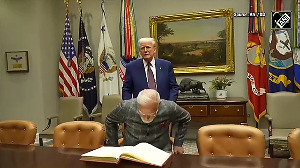The saving grace of Shankar's expanded universe is the masterful precision with which Kamal Haasan drops himself into a messy setup, only slightly to elevate the pulpy tendencies of Shankar's vision, observes Arjun Menon.

Shankar's ambitious sequel to his bellowed classic Indian (1996) is all things we expect from late-stage films by the director known for his larger-than-life commercial tentpole films, that thrives on anti-establishment themes.
Indian 2 has all the trademarks of a flamboyant, maximalist film-maker, relying on a beloved creation to expand on some of his flashy narrative ideas, with infuriatingly baffling results.
Kamal Haasan returns as the elderly vigilante 'Senapathy', who when we last saw him after much moral deliberation was forced to kill his son once he became a weed in the cogs of the corrupt system, in the first Indian.
The noble lone warrior, set out to eradicate the failings of a nonchalant system is the basic tenet of Shankar's singular filmography.
However, in Indian 2, the handmade quality of the original film is foregone for a hyper-sanitised, overtly manufactured aesthetic, where the details of Senapathy's escapades to restore systematic good faith and social conduct becomes a bouncing board for Shankar's ever-imaginative brain to take over.
The emotional grounding of the father-son conflict in the earlier film served as the perfect counterbalance to the heightened fantasy of a freedom fighter turned vigilante figure embarking on a mythic journey to eradicate corruption.
However, this time around Shankar is in love with the excess of his world, that it stifles the immediacy of the social concerns being addressed in the film.
The film starts from the perspective of a gang of youngsters, running a YouTube channel, whose idealistic naivete is only met by their wide-eyed optimism as to a day when the rot slowly catches hold of the bureaucracy.
The gang, led by Siddarth is fed up of being shunned away callously by the wrongdoers, who feed on the life of the common man. The initial stretch itself feels tacky and stacked on as we rarely feel the helplessness of a younger generation dealing with issues of serious socio-political implications, due to the amateurishness of the writing.
For instance, we get a flashback supposed to feed us some insight into the relationship between Siddarth and his mother, a detail that is conveyed with a sort of straight-faced earnestness that is defeated by the strange, awkward way it's been set up in the screenplay.
You get no sense of the inner life of these people and they come off as the ciphers that are meant to be placeholders meant to represent emotion that is not earned by the film.
The young gang's hail-mary attempt at restoring the balance of the deteriorating system by bringing back Senapathy through a social media campaign is presented in a rushed montage, devoid of any real-world implications.
In Shankar's world, the whole 'Come Back Senapathy' social media campaign brings the whole wide world to a standstill and we get a sense of going through the motions, waiting for Senapathy to make his way back and starting his characteristic one-man fight for justice.
But Shankar keeps us waiting with his usual bag of tricks and he cuts back between many players and archetypes, both involved in the process of bribing, and the victims suffering the aftermath of systemic oppression.
However, the usual dramatic tension and exhilarating bite of Shankar's writing is misplaced beneath the gloss and glamour of Senapathy's newfound celebrity status, and the hero worship accompanied by Anirudh's Thatha Vararu undercuts the weight of the many tragic lives being presented to us.
That song feels totally out of place in the world of 'Senapathy' , where moral uprightness and tragic consequences unravel.
We get introduced to many industrialists and millionaires, who turn out the temporary antagonistic forces who are introduced, just to be wiped off the next scene, in some of the most curiously structured scenes that cut back between Senapathy's vigilantism and the young gang's attempt at weeding out the wrongdoers from amongst their own family and close one's.
Shankar focuses too much on the comical affectations of the kill sequences, with Senapathy's 'varma' practice being employed to get some laughs.
For instance, in one scene, an enemy is paralysed by Senapathy, only to return to a horse-like condition where he is forced to march around for the rest of the scene inside a large room, in the literal pose of a marching horse, with an amused Senapathy breaking into a long monologue citing his adverse effect on the life of poor.
The funny aside, focusing on creative 'varma types', each with its funny implication is overdone and we feel the length of these sequences drags out the central idea's promise a little too thin.
The sleight of hand and directness with which the first Indian showcased the kill sequences is directly inverted with campy affectations here, which never adds much by way of intrigue to the scenes and play out for far too long.
Whereas a slight twitch of the two fingers sufficed to impart much-needed context into Senapathy's special abilities in the 1996 film, here it's treated with little self-awareness and we get laughably absurd scenes that are over-written to the extent of self-parody.
Shankar seems to be relishing in planning out visual set pieces for each kill and adding on comedic beats to make the Senapathy encounters light-hearted and entertaining, but to little effect.
Kamal Haasan continues the emotional arc of the first installment and we get to see him relish the chance to play the timeless 'Senapathy' and the actor is locked into the part from the very first time we see him on screen.
The saving grace of Shankar's expanded universe is the masterful precision with which Kamal Haasan drops himself into a messy setup, only slightly to elevate the pulpy tendencies of Shankar's vision.
Kamal Haasan immersed in prosthetic makeup, like in the previous film, can straighten out many tacky, self-congratulatory writing with his gravitas and own personal and political ethos that somehow bleeds into his on-screen avathar.
However, the film never adds to the core conflict of Senapathy, unlike the first film which had a strong foundation of pathos and family dynamics that is singled out for the anonymity of Senapathy as an ever-present, brooding loner on the run from a determined opponent related to his past.
Priya Bhavani Shankar and Rakul Preet Singh have very limited things to do and just get individual standout scenes, where they stand up to their parents.
But they are background players along with Siddarth in the bigger world of 'Indian' Senapathy's larger plans for radical social change.
Anirudh is in his element here and uses some of A R Rahman's original themes in crucial scenes and recycles them in a respectable fashion not compromising on his own stylistic tendencies.
Ravi Varman's frames are painterly and sometimes the drab subject matter of certain scenes falls prey to the brightly lit, glossy visual palette that complicates our response to events unfolding on screen.
Siddarth is well cast as the well-meaning youngster caught between the moral compromise of personal loss and societal degradation.
However, he rarely gets to do anything except in an emotional sequence that turns the film on its head.
S J Jayasurya, who plays the film's main antagonist, is mostly relegated to chewing the scenery in an outrageously styled wardrobe.
The 'excess' of S J Surya's sleazy business tycoon is pretty much the same excess that holds back the film from some intriguing narrative ideas and story beats that lay at its centre.
For instance, in between all the demi-god-like glorification of Senapathy, Shankar pulls off a potential threat to Senapathy's self-image and social standing, in a situation when his methods are no longer relevant or practical in real life.
This is the point in the film, where I gradually sat up from my seat just to take notice of where Shankar might spin this new development into the arc of Senapathy's superhero-like yet tragic origin story.
However, this narrative line is blown out of proportion with an uncanny chase sequence and action block that never probes further into the most important offset of the new development: Is Senapathy's ways of reform relevant anymore in this day and age?
The shirtless Senapathy effortlessly making his way through a barrage of well-built young men goes on for too long and suspends the momentum of the moral question and leaves a poor taste.
Having said that, the ending regains some of the lost goodwill and is open to some interesting developments in the next installment.
We get a glimpse of Indian 3 (2025) at the end of this film and it promises a marked departure from the world of this film to another worldly place where things could be different.
Indian 2 does not cohere together as seamlessly as one hopes and works more like an overwritten prelude to the events of the next installment and that is unfortunately all it does.













 © 2025
© 2025